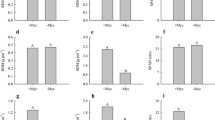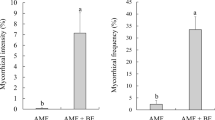Abstract
The occurrence of arbuscular mycorrhiza (AM) in nickel-(Ni)-hyperaccumulating plants of the Asteraceae family growing on Ni-enriched ultramafic soils in South Africa was surveyed. All plants were found to be consistently colonised by AM fungi, with the abundant formation of arbuscules. Berkheya coddii, which is an important species for phytomining, formed well-developed mycorrhiza under greenhouse conditions. Plants cultivated under greenhouse conditions and inoculated with native fungi had a higher shoot biomass and Ni content than noninoculated plants. Inoculation of B. coddii with Glomus intraradices (BEG) was successful, but only plants with abundantly developed arbuscules showed increased yield. In other cases, shoot biomass was similar to noninoculated plants. Dense depositions localised on top of the arbuscules were often observed in roots collected from the field and from pot cultures.


Similar content being viewed by others
References
Anderson TR, Howes AW, Slatter K, Dutton MF (1997) Studies on the nickel hyperaccumulator, Berkheya coddii. In: Jaffre T, Reeves RD, Becquer T (eds) The ecology of ultramafic and metalliferous areas. Proceedings of the Second International Conference on Serpentine Ecology, Noumea (1995), pp 2261–266
Augustyniak M, Mesjasz-Przybylowicz J, Nakonieczny M, Dybowska M, Przybylowicz W, Migula P (2002) Food relations between Chrysolina pardalina and Berkheya coddii, a nickel hyperaccumulator from South African ultramafic outcrops. Fresen Environ Bull 11:85–90
Baker AJM, Brooks RR (1989) Terrestrial higher plants which hyperaccumulate chemical elements — a review of their distribution, ecology and phytochemistry. Biorecovery 1:81–126
Baker AJM, McGrath SP, Sidli CMD, Reeves RD (1994) The possibility of in situ heavy metal decontamination of polluted soils using crops of metal-accumulating plants. Resour Cons Recycl 11:41–49
Baker AJM, McGrath SP, Reeves RD, Smith JAC (2000) Metal hyperaccumulator plants: a review of the ecology and physiology of a biological resource for phytoremediation of metal polluted soils. In: Terry N, Banuelos G (eds) Phytoremediation of contaminated soil and water. CRC, Boca Raton, Fla, USA, pp 85–107
Brooks RR, Robinson BH (1998) The potential use of hyperaccumulators and other plants for phytomining. In: Brooks RR (ed) Plants that hyperaccumulate heavy metals — their role in phytoremediation, microbiology, archaeology, mineral exploration and phytomining. CAB, Cambridge, UK, pp 327–356
Brooks RR, Chambers MF, Nicks LJ, Robinson BH (1998) Phytomining. Trends Plant Sci 3:359–362
Chaney RL, Mallik M, Li YM, Brown SL, Brewer EP (1997) Phytoremediation of soil metals. Curr Opin Biotechnol 8:279–284
Chaney RL, Lee YM, Brown SL, Homer FA, Malik M, Angle JS, Baker AJM, Reeves RD, Chin M (2000) Improving metal hyperaccumulator wild plants to develop commercial phytoextraction systems: approaches and progress. In: Terry N, Banuelos G (eds) Phytoremediation of contaminated soil and water. CRC, Boca Raton, Fla., USA, pp 129–158
Goncalves SC, Goncalves MT, Freitas H, Martins Loucao MA (1997) Mycorrhizae in a Portuguese serpentine community. In: Jaffre T, Reeves RD, Becquer T (eds) The ecology of ultramafic and metalliferous areas. Proceedings of the Second International Conference on Serpentine Ecology, Noumea (1995), pp: 87–90
Grodzińska K (1978) Mosses as bioindicators of heavy metal pollution in Polish national parks. Water Air Soil Pollut 9:83–97
Harley JL, Harley EL (1987) A check-list of mycorrhiza in the British flora. New Phytol 105:1–102
Hopkins NA (1987) Mycorrhizae in a California serpentine grassland community. Can J Bot 65:484–487
Jeffries P, Gianinazzi S, Perotto S, Turnau K, Barea JM (2002) The contribution of arbuscular mycorrhizal fungi in sustainable maintenance of plant health and soil fertility. Biol Fertil Soil (in press) (published online 5 December 2002)
Kaldorf M, Kuhn AJ, Schröder WH, Hildebrandt U, Bothe H (1999) Selective element deposits in maize colonized by a heavy metal tolerance conferring arbuscular mycorrhizal fungus. J Plant Physiol 154:718–728
Leyval C, Turnau K, Haselwandter K (1997) Effect of heavy metal pollution on mycorrhizal colonization and function: physiological, ecological and applied aspects. Mycorrhiza 7:139–153
Mahendra R, Deepak A (1999) Diversity of arbuscular mycorrhizae in naturally growing plants of family Asteraceae in India. Com Newsl 34:44–49
Mesjasz-Przybylowicz J, Balkwill K, Przybylowicz WJ, Annegard HJ, Rama DBK (1996) Similarity of nickel distribution in leaf tissue of two distantly related hyperaccumulating species. In: van der Maesen LJG, XM van der Burgt, JM van Medenbach de Rooy (eds) The biodiversity of African plants. Kluwer, Dordrecht, The Netherlands, pp 331–335
Mesjasz-Przybylowicz J, Przybylowicz WJ, Rama DBK, Pineda CA (2001a) Elemental distribution in Senecio anomalochrous, a Ni hyperaccumulator from South Africa. S Afr J Sci 97:593–595
Mesjasz-Przybylowicz J, Przybylowicz WJ, Pineda CA (2001b) Nuclear microprobe studies of elemental distribution in apical leaves of the Ni hyperaccumulator Berkhya coddii. S Afr J Sci 97:591–593
Morrey DR, Balkwill K, Balkwill M-J (1989) Studies on serpentine flora: Preliminary analyses of soils and vegetation associated with serpentinite rock formations in the south-eastern Transvaal. S Afr J Bot 55:171–177
Morrey DR, Balkwill K, Balkwill M-J, Williamson S (1992) A review of some studies of the serpentine flora of southern Africa. In: Baker AJM, Proctor J, Reeves RD (eds) The vegetation of ultramafic (serpentine) soil. Intercept, Andover, UK pp 147–157
Nicks L, Chambers MF (1998) A pioneering study of the potential of phytomining for nickel. In: Brooks RR (ed) Plants that hyperaccumulate heavy metals. CAB, Wallingford, UK pp 313–326
Orłowska E, Zubek S, Jurkiewicz A, Szarek-Łukaszewska G, Turnau K (2002) Influence of restoration on arbuscular mycorrhiza of Biscutella laevigata L. (Brassicaceae) and Plantago lanceolata L. (Plantaginaceae) from calamine spoil mounds. Mycorrhiza 12:153–159
Pawłowska TE, Błaszkowski J, Rühling A (1996) The mycorrhizal status of plants colonizing a calamine spoil mound in southern Poland. Mycorrhiza 6:499–505
Phillips J, Hayman DS (1970) Improved procedures for clearing roots and staining parasitic and vesicular-arbuscular mycorrhizal fungi for rapid assessment of infection. Trans Br Mycol Soc 55:158–161
Plenchette C, Fortin JA, Furlan V (1983) Growth response of several plant species to mycorrhizae in a soil of moderate P-fertility. I. Mycorrhizal dependency under field conditions. Plant Soil 70:199–209
Reeves RD, Baker AJ (2000) Metal-accumulating plants. In: Raskin I, Ensley BD (eds) Phytoremediation of toxic metals: using plants to clean up the environment. Wiley, New York, pp 193–229
Robinson BH, Brooks RR, Howes AW, Kirkman JH, Gregg PEH (1997) The potential of the high biomass nickel hyperaccumulator Berkheya coddii for phytoremediation and phytomining. J Geochem Explor 60:115–126
Robinson BH, Brooks RR, Clothier BE (1999) Soil amendments affecting nickel and cobalt uptake by Berkheya coddii: potential use for phytomining and phytoremediation. Ann Bot 84:689–694
Salt DE, Kramer U (2000) Mechanisms of metal hyperaccumulation in plants. In: Raskin I, Ensley BD (eds) Phytoremediation of toxic metals: using plants to clean up the environment. Wiley, New York, pp: 231–245
Salt DE, Smith RD, Raskin I (1998) Phytoremediation. Annu Rev Plant Physiol 49:643–668
Trouvelot A, Kough JL, Gianinazzi-Pearson V (1986) Mesure du taux de mycorhization VA d'un systeme radiculaire. Recherche de methodes d'estimation ayant une signification fonctionnelle. In: Gianinazzi-Pearson V, Gianinazzi S (eds) Physiological and genetical aspects of mycorrhizae. INRA, Paris, pp 217–221
Walker C, Vestberg M (1994) A simple and inexpensive method for producing and maintaining closed pot cultures of arbuscular mycorrhizal fungi. Agric Sci Finland 3:233–240
Warcup JH (1990) The mycorrhizal association of some Australian Inuleae. Muelleria 7:179–187
Warcup JH, McGee PA (1983) The mycorrhizal association of some Australian Asteraceae. New Phytol 95:667–672
Acknowledgements
This study is part of a joint South African and Polish project supported by the South African National Research Foundation and State Committee for Scientific Research (KBN), Warsaw, Poland. The authors gratefully acknowledge the assistance of the Mpumalanga Parks Boards and the permission by Sappi Forestry to access the site in Agnes Mine, in particular Dr. Martin Van Rensburg and Dr. Marc Stalmans. Thanks are due to Dr. Anna Jurkiewicz (Institute of Botany of the Jagiellonian University, Kraków, Poland) for linguistic comments on this manuscript and to Dr. Barbara Godzik (Polish Academy of Sciences, Kraków, Poland) for analysis of Ni content in plant samples.
Author information
Authors and Affiliations
Corresponding author
Rights and permissions
About this article
Cite this article
Turnau, K., Mesjasz-Przybylowicz, J. Arbuscular mycorrhiza of Berkheya coddii and other Ni-hyperaccumulating members of Asteraceae from ultramafic soils in South Africa. Mycorrhiza 13, 185–190 (2003). https://doi.org/10.1007/s00572-002-0213-6
Received:
Accepted:
Published:
Issue Date:
DOI: https://doi.org/10.1007/s00572-002-0213-6




